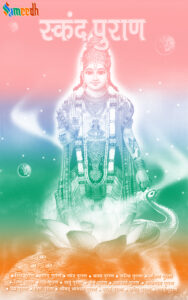The Skanda Puran is one of the eighteen Mahāpurāṇs, a genre of ancient Indian texts that contain a vast array of mythological stories, religious teachings, and historical narratives. The Skanda Puran is dedicated to Lord Kartikey, also known as Skanda, Murugan, or Subrahmanya, who is the son of Lord Shiv and Goddess Parvati.

The Puran contains a mix of mythology, cosmology, genealogies, legends, and religious teachings. It is particularly associated with the glory of Lord Kartikey and provides details about his birth, exploits, and worship. Like other Mahapurans, the Skanda Purana is divided into various sections or khandas. It consists of several books (samhitas) that are further divided into chapters (adhyayas).
The Skanda Puran, like many other Purans, is considered a part of the corpus of ancient Indian literature and mythology. The traditional attribution of the Puran is to the sage Vyasa, who is also credited with compiling the Mahābhārat and several other Purans. According to Hindu tradition, Vyasa is believed to have divided the Vedic knowledge into four parts (Rigved, Samaved, Yajurved, and Atharvaved) and then further elaborated on each branch, resulting in the creation of the Purans.
A significant portion of the Skanda Purana is dedicated to Mahatmyas, which are sections extolling the greatness of various pilgrimage sites, deities, and rituals. These Mahatmyas often include stories and legends associated with the sacred places. One of the most well-known parts of the Skand Purana is the Kartik Mahatmya, which is especially important during the Kartik month (October-November). It includes the narrative of Lord Kartikey’s victory over the demon Tarakasur and his worship during this auspicious month.
Popular Stories of Skanda Puran:
The Skanda Puran contains numerous stories and narratives, and it is quite extensive, covering a wide range of topics. Some of the popular stories from the Skanda Puran include:
- Birth of Kartikey (Skanda): The Skanda Purana narrates the story of the birth of Lord Kartikey, also known as Skanda. He is born to Lord Shiv and Goddess Parvati with the purpose of defeating the demon Tarakasur.
- Tarakasur Vadha: Lord Kartikey’s battle against the demon Tarakasur is a prominent theme in the Skanda Purana. It describes the various battles and the ultimate victory of Kartikey over the demon.
- Kartikey’s Leadership: The Puran discusses Kartikey’s leadership of the celestial armies during the devs (celestial beings) and asurs (demons) conflicts, emphasizing his role as a divine warrior.
- Kartikey’s Marriage: The Skanda Puran recounts the story of Kartikey’s marriage, often highlighting his union with Devasena and Valli. These stories are symbolic and carry moral and spiritual lessons.
- Mahatmyas (Glories of Pilgrimage Sites): A significant portion of the Skanda Purana is dedicated to Mahatmyas, which extol the greatness of various sacred places. These narratives often contain stories associated with the origin and significance of pilgrimage sites.
- Kartikey’s Worship During Kartik Month: The Puran explains the importance of Kartik month (October-November) and how the worship of Kartikey during this time is considered highly auspicious.
- The Legend of Agastya: The Skanda Puran includes stories related to the sage Agastya, describing his life, penance, and contributions to the divine narrative.
- Stories of Creation and Cosmology: Similar to other Purans, the Skanda Purana delves into cosmological concepts and the process of creation, providing mythical explanations for the origin of the universe.
It’s important to note that interpretations and emphasis on specific stories may vary across different versions and translations of the Skanda Puran. These narratives serve not only as mythological tales but also convey moral, ethical, and spiritual teachings within the context of Hindu philosophy.
The Skanda Puran is known for its comprehensive coverage of religious practices, rituals, and pilgrimage sites. It serves as a guide for devotees and provides insights into the mythological narratives associated with Lord Skanda. The Puran is considered an important source of religious and cultural knowledge in Hinduism.
